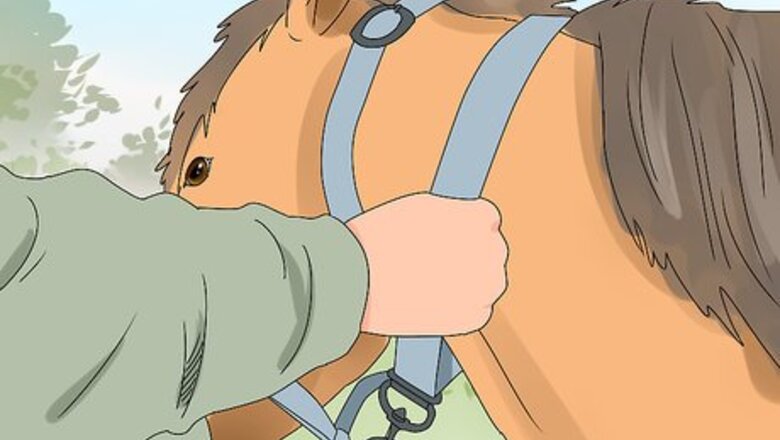
views
Fastening the Collar and Harness
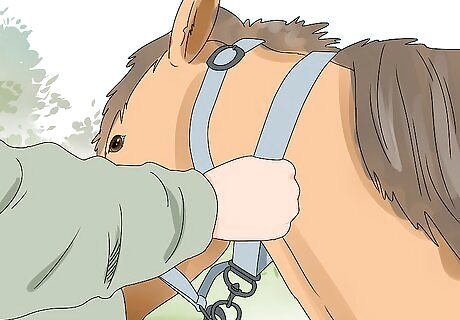
Use a collar if your horse is pulling a heavy carriage. The collar is padded to help your horse pull heavy carts like passenger carriages. Gently put the collar over the top of the horse’s head. The collar should sit at the base of the horse’s neck where it meets their body. You can put the collar on upside down if your horse has a large head or sensitive ears. After the collar is around the horse, twist it around to the correct position. The collar should fit snug across the horse’s shoulder blades. The horse pulls the cart by pushing its shoulder blades into the collar.
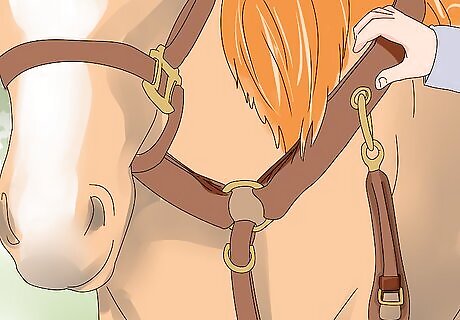
Use a breast strap if you are driving a lighter cart. The breast strap is a wide leather band that fits around the horse's chest. It is a good idea for this to be padded if possible. Bring the breast strap in front of and around the horse's chest. To hold the breast strap in place, attach the martingale to the girth and the neck strap over the horse's withers. Most drivers connect the center of the neck strap (over withers) to the top of the belly band of the harness. Fasten the buckle so the neckpiece sits securely and comfortably in the center of the horse’s chest. The martingale is a strap on the breast strap that helps control the horse’s head. The horse pulls the cart by pushing their chest into the breast strap. If the breast strap sits too high, it can push into the horse’s windpipe and cause breathing troubles. If the breast strap sits too low, it may get in the way of the horse’s leg movements.
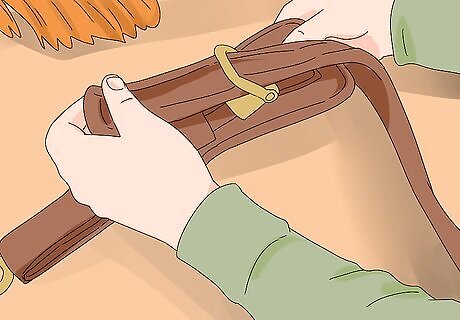
Buckle the traces to the collar or breast strap on both sides of the horse. With most light harnesses, the traces are made onto the breast strap itself. If not, on the collar or breast strap, there is a leather strap and buckle used to attach the traces. Insert 1 end of the traces and fasten it with the buckle, then attach the traces to the other side. The traces are what the horse pulls the cart with. They should be run through the belly band tie-downs and back toward the cart. They can be wrapped around the shafts or most often run through leather shaft guides then fastened to the cart itself at special hooks.

Place the saddle and breeching around the horse’s body. Put the saddle on your horse so sits just behind the withers (base of the neck above the shoulders). Secure the saddle strap around the horse behind its front legs. Place the end with the breeching around the back end of your horse. Then, gently pull the horse’s tail above the breeching. The saddle is made from leather straps and doesn’t look like a riding saddle. The saddle and breeching also have small leather straps that sit across the horse’s back called ornaments. You can simply slide them apart across the saddle area. Attached to the saddle are leather loops called tugs, which hold the shafts of your cart in place. The breeching works as the brakes of the cart or carriage.
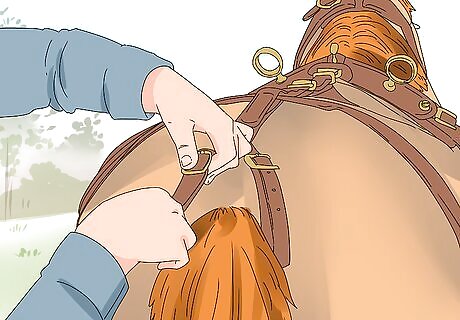
Fasten the crupper around the horse’s tail. The crupper is a padded leather loop that goes around the horse’s tail to keep the saddle in place. Loop the crupper around the horse’s tail, and fasten the buckle to secure it in place. Your crupper should not be too tight that it raises up the horse’s tail or pulls back on the saddle.
Attaching the Traces, Bridle, and Reins

Attach the girth around your horse’s body to keep the saddle in place. On the saddle are leather straps called the girth (or the belly band). Feed the leather strap into the buckle, and secure it so the girth is tight. You should be able to fit your fingers underneath the strap. The girth stops the shafts from going backward if the cart or carriage gets unbalanced.
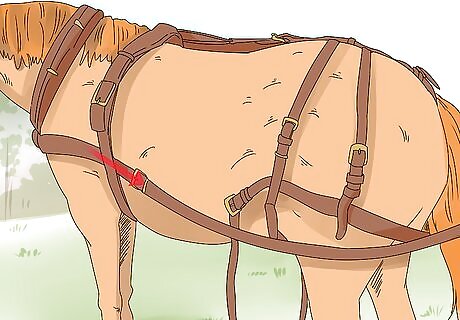
Run the traces behind the girth. Take the leather straps of the traces, and place each of them behind the leather straps of the belly band. They should sit on top of the saddle’s leather strap (behind the horse’s front legs).
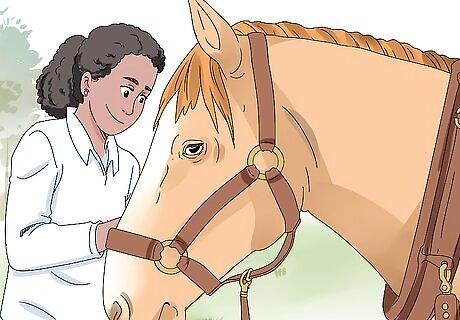
Place the bridle around your horse’s head and the bit in their mouth. The bridle will easily fit over their head. Then, place the bit inside the horse’s mouth so their tongue lies underneath. Attach the curb chain to the hook on both sides of the bit so the bridle stays put on their head. The bit is a slightly curved metal piece that sits in the horse’s mouth. This helps control the horse. Connected to the bit is a curb chain and 2 rings for the reins.
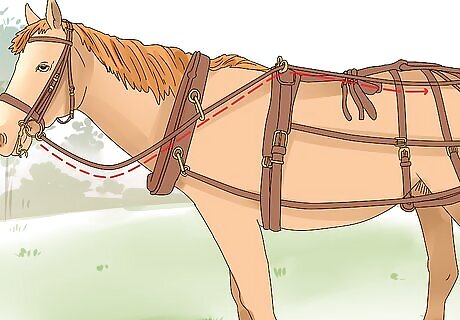
Connect the reins to the bridle and the saddle. After the bit and curb chain are in place, strap the reins to both of the rings on the bit. You can use the lower loop for more control over the horse. Run the reins through the rein tariffs on the harness and buckle up the ends. More control of the horse is helpful if you are driving on roads with traffic, for example. The rein tariffs keep the reins straight and tangle-free.
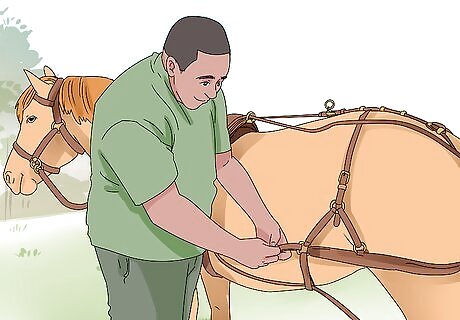
Check each strap to make sure it fits securely and comfortably. Inspect each buckle and ring to ensure each strap is properly fastened. They should fit snugly around the horse, and you should be able to fit your fingers underneath. Tighten or loosen the straps as needed.
Hitching to Carts and Carriages
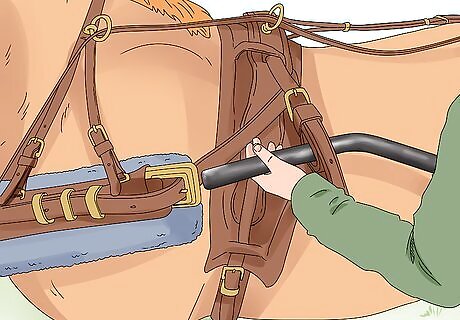
Roll the cart towards the horse and push the shafts through both togs. The horse should be familiar with the cart before you try hooking it up. The shafts are the ends of the cart that attach to the harness of the horse. The togs are small leather loops in the straps of the girth. Insert the end of the shaft into the loop of the tog on both the left and right side of the horse.
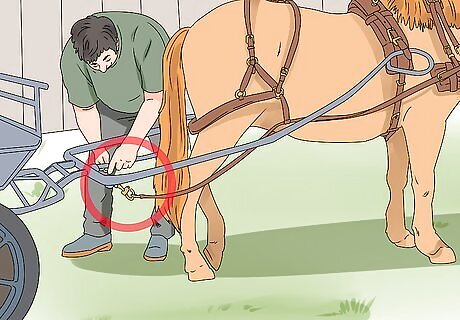
Attach the traces to the hooks on the swivel tree. The trace hook is a swirly hook at the end of the swivel tree. Line up the hole in the leather strap of the traces with the pointed end of the trace hooks, and push it around the hook until it reaches the base. Do this for both traces. The swivel tree balances out horse’s movements.
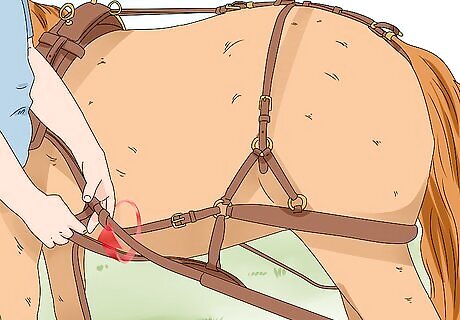
Buckle the breeching around the shaft to attach the cart or carriage. There are metal loops on the shaft to secure the breeching. Loop the leather straps of the breeching around the shaft at these metal hooks, and feed the leather strap through the loop a 2-3 times before you buckle it. The breeching controls the stopping of the cart and prevents it from running into the horse.

Ensure the shaft is properly placed by checking the belly band. The girth or the belly band helps hold the shafts in place. Lift up on the shafts to make sure they are properly placed inside the togs and the belly band is securely holding the shafts. Without the belly band, the entire cart or carriage could flip over.
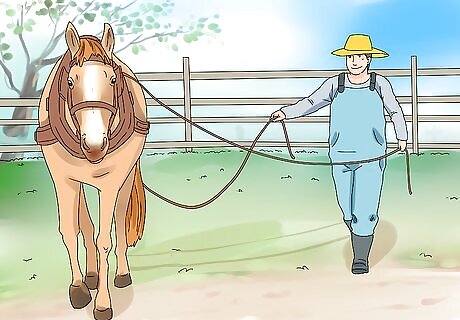
Walk your horse 4–5 ft (1.2–1.5 m) feet to check the straps and buckles. To make sure everything is properly fastened and the horse is comfortable, check your harness after you let your horse walk a few feet. Tighten or loosen the straps as needed.


















Comments
0 comment